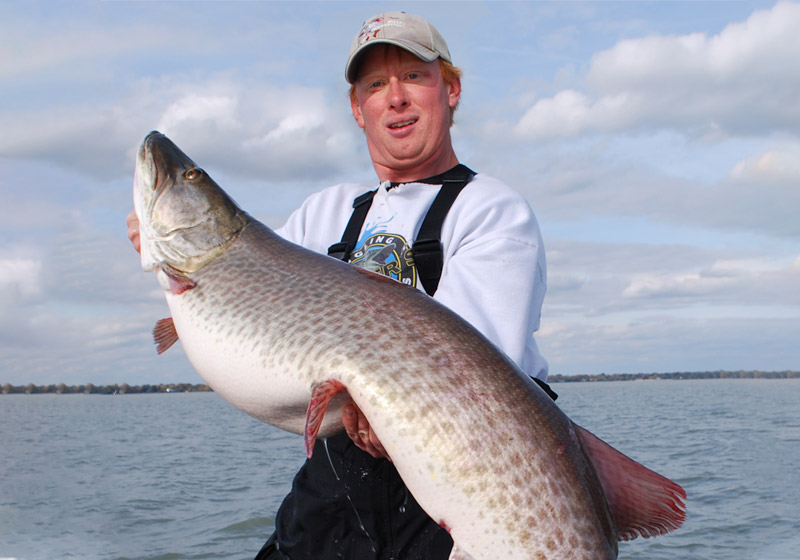Understanding the Open Water Casting Equation

One of the questions I get asked most frequently is "how did you start casting on Lake St. Clair since it has no structure and was always known as trolling lake?" The answer is a combination of two things, luck and desperation. In June of 2010 the season on Lake St. Clair had just opened and the first week or so we were finding good numbers and more importantly some big fish in shallow spawning bays. However, as the water warmed up the fish pushed out toward open water and each day in my boat we seemed to contact few and fewer fish. As our fishing was getting worse and worse I was hearing reports that the south end of the lake, known as being "troller's water" due to its complete lack of structure, was simply on fire. My good friend Captain Jason Quintano had just put up an insane 24 fish day with multiple over 50 inches. I asked Jason if any of the weed beds near there had started to come up. He told me they hadn’t and that all their trolling fish were coming in open water not related to anything other then bait fish. Since I prefer to target fish casting, I decided to stick with the weed beds on the north end of the lake. In the following three days I had a total of two fish in my boat, both under 36 inches. With reports still red hot from the trollers I decided that I had nothing to lose, and that even without any structure around, if there are that many fish in open water I should be able to at least get a few fish randomly drifting around out there. The next day we boated 13 fish casting, including a 53 and a 52 incher. Later that night I called my good friend who is the owner of Musky Innovations and told him "I am not sure what exactly I have figured out but I am pretty sure it’s a big deal."
Although open water fishing has always been considered to be a strictly trolling game, stories like this prove that nothing could be farther from the truth. If you take the time to understand how the open water equation works you will quickly realize that there are many situations where casting in open water not only is possible but also makes a lot of sense.
The Casting Advantage
How is it that a caster with one line per person can hope to compete with a troller who is running two or three lines per person? Well, the answer is something I have called the casting advantage and it applies everywhere you can find muskies. This simple math equation demonstrates to us how a caster can make up for his extreme disadvantage in the ground covered. After the 2011 musky season, I decided to compare my clients and my casting numbers with Captain Jason Quintano’s trolling numbers for the year. We had worked together all season and fished similar areas sharing information and locating hot spots together. First I compared ground covered on average, per day.
Trolling: 12 lines in the water (on average) X 4 mph trolling speed X 12 hours a day = 576 lure miles traveled per day.
Casting: 3 lines per day X 1.5 mph retrieve speed X 12 hours a day = 54 lure miles traveled per day.
After that, I ran the numbers on our fish caught per day and found that we produced roughly 60% of the fish that the troller’s got and we had a better size average. Considering that we covered less then 10% as much water as the troller’s had, how is it possible that we were able to catch 60% as many fish? There are actually several reasons for this. The biggest principal that makes this probable is that muskies, especially big ones, don’t simply bite the first lure they see. In fact they will let hundreds of lures go over their heads without skipping a beat until they find one that trips their trigger. For this reason a caster who can impart unique action into his bait can trigger a much higher percentage of the fish that see his bait then a troller who is restricted to only straight moving baits. This dramatic increase in the bites per fish contacted is what I call the casting advantage. This concept opens the door for anglers to go out and try casting in areas that have always been thought of as only trolling bites, such as the open water of Lake St. Clair. When you take this a step further and combine this principle with a casters ability to position themselves on the prime spot in every trolling pass using his electronics, water color and other less obvious structural elements you can come to expect huge results!
Electronics
Regardless of whether you are casting or trolling in open water one of the biggest tools you have is your electronics. For a troller you are going to be able to cover a lot more water so you can negate spotty use of your electronics much easier by pure volume of water covered. If you are casting you won't have that advantage. For this reason it becomes imperative to not only have good electronics, but more importantly to understand how to use them.
When you are fishing featureless open water areas, the key thing you are looking for is schools of baitfish. Find the food and you will find the muskies. Luckily for the fisherman, it is actually quite a bit easier to find these large schools of baitfish then it is to find muskies. This is because a large school of baitfish can easily be the size of a car or bigger, and they are normally densely packed making them stick out like a sore thumb on good electronics. However, when you locate a school of baitfish in open water it is not like finding a giant weed bed that you can fish around for hours. You then need to establish if the school is a fluke or if there are a bunch more schools of bait in the area. You are looking for areas that have consistent schools of bait. Once you have located a stretch in open water with good bait, then it is necessary to try to determine where the best congregations of bait are in the area. The “spot on the spot” so to speak. Once you have determined this you then have found the location I would focus my casting efforts on.
There are three basic techniques you can use to locate these baitfish schools in open water using your electronics. First if you know where some good open water bait fish areas are going to be then you can go out and start casting at them and use your electronics as you fish to determine the best spots. This concept only works if you go in with a good starting point. If you show up on the spot and you are not marking good bait then you will have to either expand your search to see if the bait fish and muskies have only moved a short distance. Normally they follow wind or water clarity changes. If this doesn't work then you are going to be forced to employ one of the two following options. The first is to drive through areas without fishing and simply use your electronics to locate schools of bait. This option, although boring, is very effective because it gives you a lot of flexibility due to the fact that you don’t have any lures in the water. This allows you to move between potential areas quickly until you start marking bait. The second option is to troll potential areas and over the course of a few hours determine where you are marking the most baitfish as well as any spots you have contacted muskies. At that point you can come back to cast the best-looking areas.
Although the concept of locating fish in open water using electronics can seem daunting, you will come to learn that there are actually several huge advantages in locating these fish as opposed to structure fish. For example, when you look at a shallow weed bed how do you determine whether or not there are muskies in it? Of course you can look at the type of weeds, how green they are, how many baitfish you see around the weeds, etc., however all of these things are only going to allow you to make an educated guess. At the end of the day, the only way to say for sure what is in that weed bed is to go and actually throw lures over it and see what comes out. Open water fishing with good electronics on the other hand can actually eliminate this guess work. When you are not marking fish don't waste your time fishing there. Good electronics can not only tell you with 100% certainty if there are fish in an area, but the use of technology such as side imaging can actually make very accurate estimates as to how many schools of bait are in an area, as well as how many muskies. This concept of knowing whether or not you are around fish and even how many are in the area is something that is unique to open water fishing.
Advanced Electronics
Since electronics are your biggest weapon while fishing open water, it is no shock that some of the new advances we have recently seen are playing a huge role in open water fishing. In my opinion, side imaging is easily the greatest advancement in this type of fishing since GPS. Using electronics such as Humminbird side imaging you are going to be able to cover up to a 240 foot stretch of water on either side of your boat rather then only what is beneath you. This allows you to cover hundreds of times more water in a single pass. Additionally, side imaging allows you to mark baitfish that are suspended high in the water column that would be spooked by the boat and would part like the red sea as you go through them making them invisible on basic sonar. This is most common with schools of shad which frequently suspend in the top 20 feet of the water column or higher. Now, add to the equation new innovations such as Humminbird's 360 degree imaging and we can expect to see electronics continue to make open water fishing easier and easier.
Water Clarity
Another extremely useful tool in locating prime casting spots in open water is water clarity. Often times the lakes where you are going to be fishing open water situations are going to have variable water clarity thus adding a key dynamic to your locational puzzle. Due to the lack of any real structural elements holding these fish, you will instead find the bait relating to the water clarity. It is the same principle when you are deep-sea fishing and you hear people say you need to go to the "blue water." In ocean fishing, this is because you are fishing over extremely deep water and the structure is so far beneath you that it does not play a factor. Therefore the baitfish and predator fish are going to be relating primarily to the watercolor aka the "blue water."
When evaluating the watercolor in your lake you will find that different types of baitfish have different preferences on which water clarity they prefer. Shad, for example, like water with some stain in it due to the fact that they are filter feeders and therefore eat microparticles in the water. Water that is gin clear is going to contain nothing for shad to eat so you will need to key in on areas that have some stain in the water. On the other hand, cisco eat a lot of insect larva and are going to be in areas where the water color is right for whatever insects are hatching. I realize that you are not going to be able to pole the various baitfish on which water color they prefer in each lake. However, when you are out fishing always take note of the water color that seems to be holding the most baitfish and muskies. As you accumulate time on the water you will begin to see obvious patterns emerging with the watercolor or water visibility always correlating with the best success.
Subtle Structure
As you spend more and more time trolling or casting in open water you will tend to notice that despite a lack of any obvious structure you tend to catch fish and big fish in the same basic spots. Lake St. Clair for example, is absolutely notorious for this. Over the last two years my boat has had three fish at or over 55 inches in it and despite the lake being 274,000 acres, those three fish have been caught within 250 feet of one another. At first glance this area appears to have absolutely no reason that the fish would be located there. However, after putting a ton of big fish waypoints on this spot I finally decided to take and put an underwater camera on it. I came to realize that it was a sand patch about three football fields in length in an area where the bottom content was mostly mud. There is zero change in depth and it would be nearly impossible to notice as you went over it unless you knew what to look for. For this reason it is important to always waypoint all your musky contacts and use that information to help to identify these hotspots.
Once you locate these prime “spot on the spot” locations in open water you will come to realize that they are much different then prime structure spots such as rock bars and weed beds. On classic prime structural spots you can pull up on them at any point in the season and hope to catch fish. In contrast, the open water spots are only going to be productive when the conditions dictate that the fish have moved into that specific area. What this means is that if the fish are in open water two miles off shore then you can look to your few basic hot spots that tend to hold fish when they congregate two miles off shore. However lets say you have a wind change and the water color shifts and the fish leave that area going out an additional two miles. When this happens you will need to focus on your hot spots four miles off shore and the prime spots two miles off shore will no longer be worth your time. Once the conditions change and the fish are again two miles off shore then those original hot spots will again be your top producers. These subtle structural hot spots allow you to limit your need to cover water by knowing where the “spot on the spots” are going to be in each area and therefore will help you to better cast each location.
There is little doubt that the future of musky fishing is going to involve more and more big water fishing. Although it is preached that you have to troll and cover water on these larger systems, when you do the math and apply these concepts of open water casting, you will come to realize that casting is not only a possibility but can be a top producing method in any situation.
HOURS
Monday
7:00am - 8:00pm
Tuesday
7:00am - 8:00pm
Wednesday
7:00am - 8:00pm
Thursday
7:00am - 8:00pm
Friday
7:00am - 8:00pm
Sat. & Sun.
7:00am - 8:00pm
Spencer's Angling Adventures
29474 Old North River Road
Harrison Township, MI 48045
(419) 410-0498


